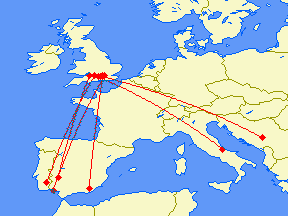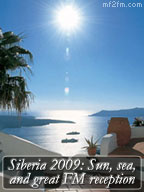Thursday 13 July, 2006, 08:36 - Licensed
Driving along the M4 motorway yesterday evening, I was trying to listen to the news on BBC Radio 4. As usual, the RDS Alternative Frequency (AF) service was doing a good job at re-tuning my radio to a new transmitter once I disappeared out of the coverage of the one I was tuned to. Not long into my journey I noticed that my radio was struggling to find a clear frequency and that even the best it could find was swamped by interference. Having experienced this before, I wondered whether there might be Sporadic-E propagation around. A quick tune to the low end of the FM band confirmed there was.Sporadic-E propagation exists when the sun's radiation ionises layers of gas in the 'E'-layers of the ionosphere. These ionised layers refract radio signals, often up to high VHF frequencies, enabling signals from far afield to be easily received. Usually such ionisation forms in relatively small 'clouds' such that the signals which are refracted in any one area might differ significantly from those received in another. Often from any given point the signals received are from one specific area.
It can be fun tuning around the FM band at times when Sprodic-E is active as stations from typically 1,000 or more miles away can swamp local stations. With the advent of RDS it's also relatively easy to identify the location of the transmitter you are hearing. A good place to listen (in the UK) is the bottom end of the FM band (87.5 - 88.0 MHz) where, unless there is a local RSL station active, there tends to be nothing but static. This is also the frequency range that is first to respond when the Sporadic-E clouds are around. Yesterday, for example, the highest frequency on which I could hear foreign stations was around 90 MHz.
 On my journey yesterday I logged the following stations (the location has been added in after a brief web-search). The map on the right shows the path between me and these stations - you can pretty much see that there must have been 2 'clouds' (one over the Bay of Biscay and the other somewhere near Austria) and how the areas where signals were received from are similar:
On my journey yesterday I logged the following stations (the location has been added in after a brief web-search). The map on the right shows the path between me and these stations - you can pretty much see that there must have been 2 'clouds' (one over the Bay of Biscay and the other somewhere near Austria) and how the areas where signals were received from are similar:87.6 Radio Speranza (Pescara, Italy)
87.7 Antena 1 (Mendro, Portugal)
87.7 HRT HR-1 (Pljesvica, Croatia)
87.8 RNE-3 (Baza, Spain)
87.9 Canal Extremadura (Merida, Spain)
88.0 RNE-5 (probably Huelva, definitely Spain!)
There was also a very strong Spanish station on 88.5 MHz but it never quite registered its RDS and as such remains a mystery! There were also other stations fading in and out, many Spanish, some Italian and Portuguese and a few French, however none were receivable long enough to register their name or RDS.
None of this is particularly amazing.
 Sproadic-E propagation is common, especially during the summer months. However, it is most common at the height of the sun's 11 year solar cycle. At the moment, though, the sun is at the lowest point of its 11 year cycle. And radio amateurs monitoring the 6 metre amateur band have also regularly experienced enhanced propagation over the past 2 months. This shouldn't really occur. It might be that the sun has been a bit more lively than it should have been - I'm useless at interpreting the complex solar data - but those that do can tell me that the recent conditions are not normal. So what is going on? My own theory, for what it's worth, is that propagation conditions are not just a function of the sun's activity but are also connected to weather conditions here on Earth. This year in the UK we've had at least 3 weeks of weather where temperatures were 10C above the seasonal norm. Could global warming also be playing havoc with radio propagation? If anyone has a few hundred thousand pounds to spare, I would be happy to investigate further!
Sproadic-E propagation is common, especially during the summer months. However, it is most common at the height of the sun's 11 year solar cycle. At the moment, though, the sun is at the lowest point of its 11 year cycle. And radio amateurs monitoring the 6 metre amateur band have also regularly experienced enhanced propagation over the past 2 months. This shouldn't really occur. It might be that the sun has been a bit more lively than it should have been - I'm useless at interpreting the complex solar data - but those that do can tell me that the recent conditions are not normal. So what is going on? My own theory, for what it's worth, is that propagation conditions are not just a function of the sun's activity but are also connected to weather conditions here on Earth. This year in the UK we've had at least 3 weeks of weather where temperatures were 10C above the seasonal norm. Could global warming also be playing havoc with radio propagation? If anyone has a few hundred thousand pounds to spare, I would be happy to investigate further!2 comments
( 2111 views )
| permalink
| 



 ( 3.1 / 14958 )
( 3.1 / 14958 )




 ( 3.1 / 14958 )
( 3.1 / 14958 )

